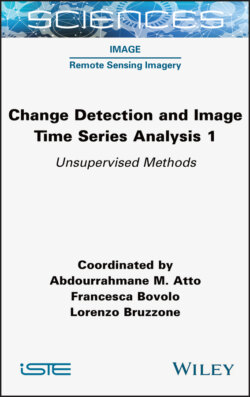Читать книгу Change Detection and Image Time-Series Analysis 1 - Группа авторов - Страница 19
1.3.2.1. SCV reconstruction based on multiscale morphological processing
ОглавлениеIn the standard C2VA, a SCV indicates a pixel that is unchanged or has a possible kind of change according to its specific signature and constructed change variables (i.e. ρ and θ). However, the original SCVs may contain abnormal spectral variations and noises, which may lead to a high number of omission and commission errors. To address this problem, the morphological profile (MP) is applied to better model and preserve the geometrical structure of change targets. It is defined as a sequence of mathematical closing and opening operations on the image with different structural element (SE) sizes. In particular, opening by reconstruction (OR) and closing by reconstruction (CR) (Benediktsson et al. 2005) for a gray-level image f are defined as:
[1.8]
[1.9]
where i is the radius of the SE. Here, δi(·) and εi(·) are the dilation and erosion operations, respectively. Rδ and Rε are the geodesic reconstruction by dilation and erosion, respectively. In particular, the components of MP, i.e. OR and CR, are able to suppress brighter and darker regions, respectively, that are smaller than the moving SE, while preserving the geometrical characteristics of a region larger than the SE (Dalla Mura et al. 2010). Small isolated objects are merged into a surrounding local background while the main structure is kept. Due to the fact that different image objects usually have different sizes, multiscale representation allows us to explore different hypothetical spatial domains by using a range of SE sizes, in order to obtain the best response for different structures (Mura et al. 2008).
Figure 1.3. Block scheme of the proposed M2C2VA technique
For the B-dimensional SCVs XD, at a given scale i, its OR and CR are also B-dimensional:
[1.10]
[1.11]
Note that either can be used as an input for the detector (e.g. S2CVA), but ambiguities may arise due to the selection of a specific operator (i.e. OR or CR) and its consequential effects (i.e. suppression of brighter or darker objects). The joint use of OR and CR is likely to be more reliable. In this work, the four-connected neighborhood was considered, and the marker and mask image represented the dilation result and the original input band (for OR) (or complement image of the original input band for CR), respectively. A disk shape was selected for the SE, which has been demonstrated to be a robust shape in different scenarios (Benediktsson et al. 2005; Mura et al. 2008). The size of the SE i was increased from 1 to 6, in order to implement a multiscale analysis using the reconstructed SCVs.
